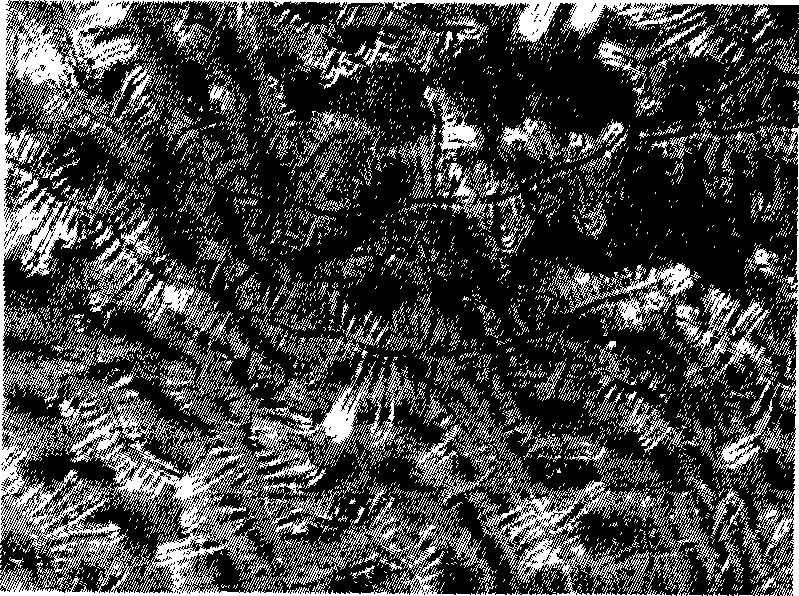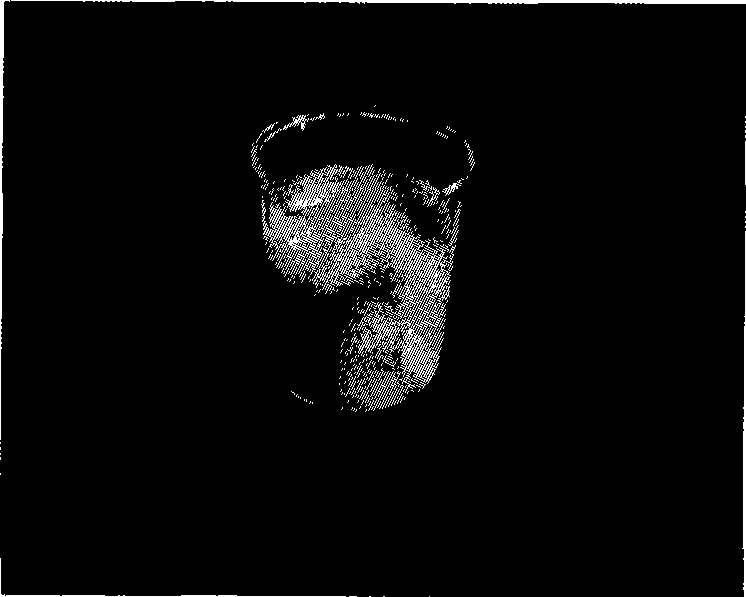Cartilage cell epimatrix three-dimensional porous sponge stent for tissue engineering and preparation method thereof
A three-dimensional porous, chondrocyte technology, applied in bone implants, medical science, prostheses, etc., can solve the problem of low biomechanical strength of cell-particle complexes, difficulty in sending metabolites from nutrients, and uneven mixing of chondrocytes To achieve the effect of extensive material sources, no risk of disease transmission, and good clinical application prospects
- Summary
- Abstract
- Description
- Claims
- Application Information
AI Technical Summary
Problems solved by technology
Method used
Image
Examples
Embodiment 1
[0070] Soak human articular cartilage in PBS buffer (pH7.5) at 4°C, the buffer contains 0.035% PMSF (w / v) and 0.1% EDTA, immediately pulverize it with a pulverizer, and use gradient centrifugation to obtain cartilage with a diameter of 100nm to 5μm Microfilament ( figure 1 ). Add 10mmol / L Tris-HCl buffer solution (pH7.5) containing 1% Triton X-100 at 4°C, and the content of PMSF in the buffer solution is the same as above. Continue shaking for 24 hours to remove cellular components. Wash with PBS after centrifugation at 7000r / min for 5min. Add 50U / mL DNase and 1U / mL RNase to digest at 37°C for 6-48h. Rinse with triple distilled water after centrifuging in the same way, and the precipitate is made into a white milky suspension with a mass volume ratio of 3% ( figure 2). Put the suspension into a mold, store at -20°C for 24 hours, store at -80°C for 1 hour, and freeze-dry in a freeze dryer for 48 hours to make a three-dimensional porous scaffold material. The obtained car...
Embodiment 2
[0081] Example 2: The effect of the content of decellularized cartilage microfilaments on the microstructure of the cartilage extracellular matrix three-dimensional porous sponge scaffold
[0082] Grind the fresh articular cartilage in a pulverizer, centrifuge at 1500rpm for 5min with density gradient centrifugation, take the milk-like supernatant, use 1% Triton X-100 to continuously shake at 4°C for 48h to remove cell components, centrifuge at 7000rpm and wash with distilled water Rinse repeatedly. The precipitates were respectively made into (by weight) 1% and 2% suspensions, and the solutions were injected into pre-cooled molds, and the freeze-freeze method was used to freeze at -20°C for 24 hours, and then freeze in a freeze dryer. After drying, three-dimensional porous sponge scaffolds of cartilage extracellular matrix with different pore sizes and microstructures were obtained. see Figure 21 with 22 . Under the same freezing temperature and freezing rate, the pore s...
Embodiment 3
[0083] Example 3: Crosslinking of Cartilage Extracellular Matrix Three-dimensional Porous Sponge Scaffold
[0084] Grind the fresh articular cartilage in a pulverizer, centrifuge at 1500rpm for 5min by differential centrifugation, take the milk-like supernatant, use 1% Triton X-100 to shake continuously at 4°C for 48h to remove cell components, centrifuge at 7000rpm and use Rinse repeatedly with distilled water. The precipitates were made into (by weight) 2% suspension, the solution was injected into a pre-cooled mold, and the freeze-freeze method was used to freeze at -20°C for 24 hours, and then freeze-dried in a freeze dryer to obtain Three-dimensional porous sponge scaffold of cartilage extracellular matrix.
[0085] (1) The scaffold was cross-linked at 110°C for 5 h by vacuum dry thermal method, then immersed in 14 mM EDAC and 5.5 mM NHS solution for cross-linking for 2 h, rinsed three times with PBS and twice with three-distilled water, and then freeze-dried the scaffol...
PUM
| Property | Measurement | Unit |
|---|---|---|
| diameter | aaaaa | aaaaa |
| diameter | aaaaa | aaaaa |
| porosity | aaaaa | aaaaa |
Abstract
Description
Claims
Application Information
 Login to View More
Login to View More - R&D
- Intellectual Property
- Life Sciences
- Materials
- Tech Scout
- Unparalleled Data Quality
- Higher Quality Content
- 60% Fewer Hallucinations
Browse by: Latest US Patents, China's latest patents, Technical Efficacy Thesaurus, Application Domain, Technology Topic, Popular Technical Reports.
© 2025 PatSnap. All rights reserved.Legal|Privacy policy|Modern Slavery Act Transparency Statement|Sitemap|About US| Contact US: help@patsnap.com



